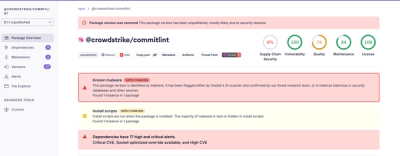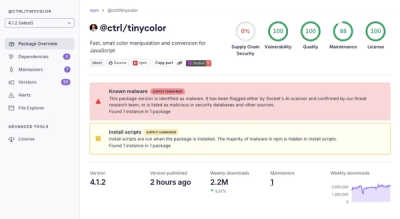React ViewPort List





If your application renders long lists of data (hundreds or thousands of rows), we recommended using a technique known as “windowing”. This technique only renders a small subset of your rows at any given time, and can dramatically reduce the time it takes to re-render the components as well as the number of DOM nodes created.
- React.js documentation
📜 Virtualization for lists with dynamic item size
Features 🔥
- Simple API like Array.Prototype.map()
- Created for dynamic item
height or width (if you don't know item size)
- Works perfectly with Flexbox (unlike other libraries with
position: absolute)
- Supports scroll to index
- Supports initial index
- Supports vertical ↕ and horizontal ↔ lists️️
- Tiny (about 2kb minified+gzipped)
Try 100k list demo
Getting Started
-
Installation:
npm install --save react-viewport-list
-
Basic Usage:
import { useRef } from 'react';
import { ViewportList } from 'react-viewport-list';
const ItemList = ({
items,
}: {
items: { id: string; title: string }[];
}) => {
const ref = useRef<HTMLDivElement | null>(
null,
);
return (
<div className="scroll-container" ref={ref}>
<ViewportList
viewportRef={ref}
items={items}
>
{(item) => (
<div key={item.id} className="item">
{item.title}
</div>
)}
</ViewportList>
</div>
);
};
export { ItemList };
MutableRefObject<HTMLElement / null> / RefObject<HTMLElement / null> / { current: HTMLElement / null } / null
Props
viewportRef | MutableRefObject<HTMLElement / null> / RefObject<HTMLElement / null> / { current: HTMLElement / null } / null | required | Viewport and scroll container.
document.documentElement will be used if viewportRef not provided. |
items | T[] | [] | Array of items. |
itemSize | number | 0 | Item average (estimated) size (height for axis="y" and width for axis="x") in px.
Size should be greater or equal zero.
Size will be computed automatically if itemMinSize not provided or equal zero. |
itemMargin | number | -1 | Item margin (margin-bottom for axis="y" and margin-right for axis="x") in px.
Margin should be greater or equal -1.
Margin will be computed automatically if margin not provided or equal -1.
You should still set margin in item styles |
overscan | number | 1 | Count of "overscan" items. |
axis | "y" / "x" | 'y' | Scroll axis:- "y" - vertical
- "x" - horizontal
|
initialIndex | number | -1 | Initial item index in viewport. |
initialAlignToTop | boolean | true | scrollIntoView param.
Used with initialIndex |
initialOffset | number | 0 | Offset after scrollIntoView call.
Used with initialIndex.
This value will be added to the scroll after scroll to index. |
initialDelay | number | -1 | setTimeout delay for initial scrollToIndex.
Used with initialIndex. |
initialPrerender | number | 0 | Used with initialIndex.
This value will modify initial start index and initial end index like [initialIndex - initialPrerender, initialIndex + initialPrerender].
You can use it to avoid blank screen with only one initial item rendered |
children | (item: T, index: number, array: T[]) => ReactNode | required | Item render function.
Similar to Array.Prototype.map(). |
onViewportIndexesChange | (viewportIndexes: [number, number]) => void | optional | Will be called on rendered in viewport indexes change. |
overflowAnchor | "none" / "auto" | "auto" | Compatibility for overflow-anchor: none.
Set it to "none" if you use overflow-anchor: none in your parent container styles. |
withCache | boolean | true | Cache rendered item heights. |
scrollThreshold | number | 0 | If scroll diff more than scrollThreshold setting indexes was skipped. It's can be useful for better fast scroll UX. |
renderSpacer | (props: { ref: MutableRefObject; style: CSSProperties; type: 'top' / 'bottom' }) => ReactNode | ({ ref, style }) => <div ref={ref} style={style} /> | In some rare cases you can use specific elements/styles instead of default spacers |
count | number | optional | You can use items count instead of items directly. Use should use different children: (index: number) => ReactNode |
indexesShift | number | 0 | Every time you unshift (prepend items) you should increase indexesShift by prepended items count. If you shift items (remove items from top of the list you should decrease indexesShift by removed items count). |
getItemBoundingClientRect | (element: Element) => DOMRect / { bottom: number; left: number; right: number; top: number; width: number; height: number; } | (element) => element.getBoundingClientRect() | You can use custom rect getter to support display: contents or other cases when element.getBoundingClientRect() returns "bad" data |
Methods
scrollToIndex
scrollToIndex method has only one param - options;
Options param
index | number | -1 | Item index for scroll. |
alignToTop | boolean | true | scrollIntoView param. Only boolean option supported. |
offset | number | 0 | Offset after scrollIntoView call.
This value will be added to the scroll after scroll to index. |
delay | number | -1 | setTimeout delay for initial scrollToIndex. |
prerender | number | 0 | This value will modify initial start index and initial end index like [index - initialPrerender, index + initialPrerender].
You can use it to avoid blank screen with only one initial item rendered |
Usage
import { useRef } from 'react';
import { ViewportList } from 'react-viewport-list';
const ItemList = ({
items,
}: {
items: { id: string; title: string }[];
}) => {
const ref = useRef(null);
const listRef = useRef(null);
return (
<div className="scroll-container" ref={ref}>
<ViewportList
ref={listRef}
viewportRef={ref}
items={items}
>
{(item) => (
<div key={item.id} className="item">
{item.title}
</div>
)}
</ViewportList>
<button
className="up-button"
onClick={() =>
listRef.current.scrollToIndex({
index: 0,
})
}
/>
</div>
);
};
export { ItemList };
getScrollPosition
getScrollPosition returns an object with scroll position: { index: number, offset: number }
Returns
index | number | Item index for scroll. |
offset | number | Offset after scrollIntoView call.
This value will be added to the scroll after scroll to index. |
If items=[] or count=0 getScrollPosition returns { index: -1; offset: 0 }
Usage
import { useEffect, useRef } from 'react';
import { ViewportList } from 'react-viewport-list';
const ItemList = ({
items,
}: {
items: { id: string; title: string }[];
}) => {
const ref = useRef(null);
const listRef = useRef(null);
useEffect(
() => () => {
window.sessionStorage.setItem(
'lastScrollPosition',
JSON.stringify(
listRef.current.getScrollPosition(),
),
);
},
[],
);
return (
<div className="scroll-container" ref={ref}>
<ViewportList
ref={listRef}
viewportRef={ref}
items={items}
>
{(item) => (
<div key={item.id} className="item">
{item.title}
</div>
)}
</ViewportList>
<button className="up-button" />
</div>
);
};
export { ItemList };
Performance
If you have performance issues, you can add will-change: transform to a scroll container.
You should remember that in some situations will-change: transform can cause performance issues instead of fixing them.
.scroll-container {
will-change: transform;
}
Children pseudo-classes
ViewportList render two elements (spacers) before first rendered item and after last rendered item.
That's why children pseudo-classes like :nth-child(), :last-child, :first-child may work incorrectly.
Margin
If you want more accurate virtualizing you should use equal margin for all items.
Also, you should use margin-top or margin-bottom (not both) for axis="y" and margin-right or margin-left (not both) for axis="x".
If you want to use different margins and stil want more accurate virtualizing you can wrap your items in some element like <div> and use padding instead of margin.
Non-keyed
You should avoid non-keyed usage of list. You should provide unique key prop for each list items.
If you have issues with scroll in Safari and other browsers without overflow-anchor support, check item's key prop.
Advanced Usage
-
Grouping
ViewportList render Fragment with items in viewport. So, grouping just work.
import { useRef } from 'react';
import { ViewportList } from 'react-viewport-list';
const GroupedItemList = ({
keyItems,
items,
}: {
keyItems: { id: string; title: string }[];
items: { id: string; title: string }[];
}) => {
const ref = useRef(null);
return (
<div className="scroll-container" ref={ref}>
<span className="group-title">
Key Items
</span>
<ViewportList
viewportRef={ref}
items={keyItems}
>
{(item) => (
<div
key={item.id}
className="key-item"
>
{item.title}
</div>
)}
</ViewportList>
<span className="group-title">Items</span>
<ViewportList
viewportRef={ref}
items={items}
>
{(item) => (
<div key={item.id} className="item">
{item.title}
</div>
)}
</ViewportList>
</div>
);
};
export { GroupedItemList };
-
Sorting
You can use React Sortable HOC
import { useRef } from 'react';
import {
SortableContainer,
SortableElement,
} from 'react-sortable-hoc';
import { ViewportList } from 'react-viewport-list';
const SortableList = SortableContainer(
({ innerRef, ...rest }) => (
<div {...rest} ref={innerRef} />
),
);
const SortableItem = SortableElement(
(props) => <div {...props} />,
);
const SortableItemList = ({
items,
onSortEnd,
}) => {
const ref = useRef(null);
return (
<SortableList
innerRef={ref}
className="scroll-container"
onSortEnd={onSortEnd}
>
<ViewportList
viewportRef={ref}
items={items}
>
{(item, index) => (
<SortableItem
key={index}
index={index}
className="item"
>
{item.title}
</SortableItem>
)}
</ViewportList>
</SortableList>
);
};
export { SortableItemList };
-
Scroll to position
Scroll to position may work incorrectly because scrollHeight and scrollTop (or scrollWidth and scrollLeft) changed automatically while scrolling.
But you can scroll to position with scrollToIndex method with { index: 0, offset: scrollPosition }. For initial scroll to position you can use initialIndex={0} and initialOffset={scrollPosition}. You should remember that after scroll happened scroll position can be not equal to specified offset.
import { useRef } from 'react';
import { ViewportList } from 'react-viewport-list';
const ItemList = ({
items,
savedScroll,
}: {
items: { id: string; title: string }[];
savedScroll: number;
}) => {
const ref = useRef(null);
const listRef = useRef(null);
return (
<div className="scroll-container" ref={ref}>
<ViewportList
ref={listRef}
viewportRef={ref}
items={items}
initialIndex={0}
initialOffset={savedScroll}
>
{(item) => (
<div key={item.id} className="item">
{item.title}
</div>
)}
</ViewportList>
<button
className="up-button"
onClick={() => {
// this sets scrollTop of "scroll-container" to 1000
listRef.current.scrollToIndex({
index: 0,
offset: 1000,
});
}}
/>
</div>
);
};
export { ItemList };
-
Tests
You can mock ViewportList for unit tests:
import {
useImperativeHandle,
forwardRef,
} from 'react';
export const ViewportListMock = forwardRef(
({ items = [], children }, ref) => {
useImperativeHandle(
ref,
() => ({
scrollToIndex: () => {},
}),
[],
);
return (
<>
<div />
{items.map(children)}
<div />
</>
);
},
);
export default ViewportListMock;








